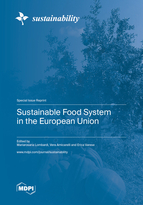Sustainable Food System in the European Union
A special issue of Sustainability (ISSN 2071-1050). This special issue belongs to the section "Sustainable Food".
Deadline for manuscript submissions: closed (30 November 2022) | Viewed by 37479
Special Issue Editors
Interests: environmental sustainability; environmental impact assessment; carbon footprint; renewable energy; bioenergy; social and technological innovation; agrifood supply chains; climate change mitigation and adaptation strategies
Special Issues, Collections and Topics in MDPI journals
Interests: material flow analysis (MFA); circular economy applied particularly to agro-food sector and food loss and waste; environmental sustainability of production and consumption processes; bioenergy (biodiesel and bioethanol)
Interests: food related aspects (e.g., food businesses, labelling, quality assurance and certification schemes, food waste management, industrial tourism); consumer science, protection and perception; international trade and customs
Special Issue Information
Dear Colleagues,
Among the efforts to tackle climate and environmental challenges, the European Green Deal (EGD) plays an important role proposing a holistic approach in which all European actions and policies contribute to the objectives of the Green Deal itself. The EGD plans new, sustainable and inclusive growth strategies to enhance the economy, people's health and quality of life, taking care for nature, and leaving no one behind. The Farm to Fork (F2F) Strategy is one of the EGD strategies focused on sustainable food systems and the complex links between healthy people, healthy societies and a healthy planet. The F2F strategy, while emphasizing the awareness that food systems remain one of the key drivers of climate change and environmental degradation, highlights the need of transition towards a green agri-food system.
The main goals of the F2F strategy are to ensure sufficient, affordable and nutritious food within planetary limits; to guarantee sustainable food production through a substantial reduction in pesticides, antimicrobials and fertilisers use and an increase in organic farming; to promote more sustainable food consumption and healthy diets; to minimize food loss and waste; to fight food fraud and to improve animal welfare. The F2F strategy’s aim can be summarized as a shift to a sustainable food system able to bring environmental, health and social benefits; offer economic gains and ensure sustainable growth paths.
This Special Issue of Sustainability intends to contribute to this field by collecting high-quality studies and research works related to the complexity of food systems to measure the progress in the achievement of F2F and EGD strategies’ goals.
This Special Issue is designed to encourage researchers to share their results by submitting original research articles, case studies, reviews, critical perspectives and viewpoint articles. The Special Issue’s final results will provide an updated picture of the effectiveness of the F2F strategy and of any corrective actions needed.Dr. Mariarosaria Lombardi
Dr. Vera Amicarelli
Dr. Erica Varese
Guest Editors
Manuscript Submission Information
Manuscripts should be submitted online at www.mdpi.com by registering and logging in to this website. Once you are registered, click here to go to the submission form. Manuscripts can be submitted until the deadline. All submissions that pass pre-check are peer-reviewed. Accepted papers will be published continuously in the journal (as soon as accepted) and will be listed together on the special issue website. Research articles, review articles as well as short communications are invited. For planned papers, a title and short abstract (about 100 words) can be sent to the Editorial Office for announcement on this website.
Submitted manuscripts should not have been published previously, nor be under consideration for publication elsewhere (except conference proceedings papers). All manuscripts are thoroughly refereed through a single-blind peer-review process. A guide for authors and other relevant information for submission of manuscripts is available on the Instructions for Authors page. Sustainability is an international peer-reviewed open access semimonthly journal published by MDPI.
Please visit the Instructions for Authors page before submitting a manuscript. The Article Processing Charge (APC) for publication in this open access journal is 2400 CHF (Swiss Francs). Submitted papers should be well formatted and use good English. Authors may use MDPI's English editing service prior to publication or during author revisions.
Keywords
- European Green Deal
- Farm to Fork
- circular economy
- food system
- green agri-food systems
- food loss and waste
- organic farming
- animal welfare
- healthy diets








